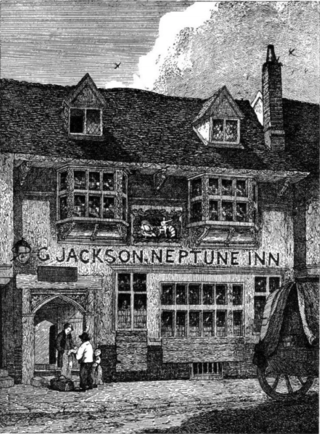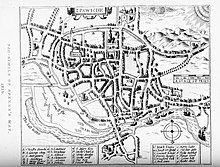
The Ipswich Racecourse is an area of Ipswich in Suffolk, England, that was formerly a racecourse from 1710 to 1911.

Wortham is a village and parish in Suffolk, England, close to the border with Norfolk. Its church, St Mary the Virgin, lies about a mile north of the present-day village. It is one of 38 existing round-tower churches in Suffolk and the one with the greatest diameter in England.
William Smarte, of Ipswich, Suffolk, was an English merchant and landowner.

Neptune Inn is an historic public house located in Fore Street, Ipswich, Suffolk, England. The building was originally built around 1490 and is grade II* listed.

Richard Dykes Alexander was a businessman and philanthropist based in Ipswich, Suffolk.

St Clement's Church, Ipswich, is a redundant church. The church is one of twelve medieval churches in Ipswich, six of which had been declared redundant by the 1970s. In the twenty-first century it was taken over by Ipswich Historic Churches Trust.

John Dupuis Cobbold was a member of the Ipswich-based Cobbold family in England.

The Steam Packet Inn was a public house located at 2/4 Duke Street, Ipswich, Suffolk, England. It closed on 18 September 1960. The building had been owned by Cobbold Brewery but after closure it was sold to Eastern Counties Farmers (ECF). The grade II listed building is now used as student accommodation.
Ipswich and Suffolk Freehold Land Society (FLS) was founded in 1849 as part of the "forty-shilling freeholders movement" which developed across England. Its aim was to enable "the ordinary man" to obtain sufficient property to meet the requirements needed to gain the vote. The movement had been started by James Taylor of Birmingham. On Saturday 1 December 1849 the first meeting of the society was advertised in the Suffolk Chronicle. Richard Dykes Alexander, the head of the Alexander banking family, was the first president.
Charles Foote Gower was an English soap manufacturer based in Ipswich. He was a significant businessman in that town.

George Green Sampson (1804-1885) was a physician and politician in Ipswich, Suffolk.

St George's Chapel, was a religious building located in Ipswich, Suffolk, England. The spot where it was located is now occupied by St George's Terrace, in St Georges Street. This lies just to the north of the historic town centre of Ipswich. It was from this chapel that Thomas Bilney was taken in 1527 and accused of heresy. No trace of the building remains.

Stoke Mill was an historic watermill located in Ipswich, Suffolk. It was located on the north bank of the River Orwell next to Stoke Bridge. It was on Bridge Street where there is now a skate park.
Christ's Hospital, Ipswich was established in Tudor Ipswich, Suffolk. The original benefactors were Richard Felaw, William Smarte and Henry Tooley.

Henry Tooley was a Suffolk, England merchant. Alive during the Tudor period, by the time of his death he was one of the richest businessmen in the town of Ipswich. He was closely associated with the fellow merchant and Member of Parliament for Ipswich, Robert Daundy. His trade network extended Biscayan ports, the Netherlands and Iceland as well as including much of East Anglia east of line drawn between Chelmsford and Thetford – and the highly populated and industry towns of south Suffolk in particular.
Frederick Brett Russell was an English architect and artist based in Ipswich, Suffolk.

William Francis Paul was a business man in Ipswich, Suffolk who was active in politics and became a benefactor to the town.

King Street, Ipswich is a street in central Ipswich.
Samuel Belcher Chapman was an English philanthropist who dedicated himself to supporting the St Matthews Industrial Home for Girls in Ipswich, Suffolk. Following a brief period in partnership with Henry Biddell in London, Chapman moved to Ipswich in 1830 and by October 1831, he had received the credentials from Apothecaries' Hall, London to practice as chemist and druggist. He then set up in business first in Tavern Street, moving to Cornhill by 1832.
West End Bathing Place was an outdoor swimming venue in Ipswich, Suffolk.














